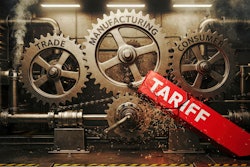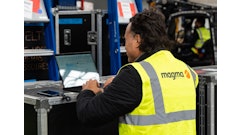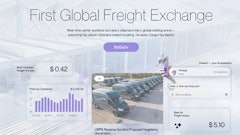
Daniel Sokolovsky, co-founder and CEO of WARP, is a trailblazer in logistics innovation, blending strategic foresight with a hands-on approach to transform how businesses move goods. His day-to-day focus lies in redefining WARP’s business model to create unparalleled efficiencies in middle-mile logistics. By leveraging a robust network of third-party cross-docks and multi-sized vehicle fleets, he ensures WARP stays ahead in providing cost-effective, flexible, and transparent freight solutions. He serves as the architect of a seamlessly integrated freight network, overseeing key performance metrics, including cost-per-mile, on-time delivery rates, and network capacity, ensuring consistent service quality across all operations. He drives the development of WARP’s proprietary technology, such as advanced TMS and real-time tracking. He works directly with large companies like Saks Off Fifth and Aritzia to design customized solutions that address complex logistics challenges. He also leads a dynamic team of logistics professionals and technology innovators, fostering an environment of collaboration, adaptability, and a relentless drive to redefine industry norms.
Under Sokolovsky's leadership, WARP has achieved a 41.91% revenue increase, projecting $32.5 million by year’s end, and expanded into 442 additional cities, totaling nearly 3,000, positioning the company as a key player in the logistics ecosystem. He's championed the integration of real-time tracking and predictive analytics, reducing shipment handling and improving visibility for customers. And, by integrating electric and hybrid vehicles into WARP’s network, Sokolovsky has aligned the company with global sustainability goals. He expanded the third-party cross-docking network, boosting shipment capacity by 132% to meet increasing client demands, and enabled clients to achieve up to a 25% reduction in logistics costs while enhancing delivery speed and reliability.
Moving forward, Sokolovsky is looking to expand WARP’s footprint to include hundreds of new locations; launch AI-driven logistics tools for enhanced route optimization, capacity utilization, and cost management; double the number of electric and hybrid vehicles in the fleet; and continue strengthening relationships with existing partners while targeting new, high-profile clients to solidify WARP’s industry dominance.
We talked exclusively with Sokolovsky about customizing supply chain solutions, the importance of partnerships in the industry and the benefits of integrating real-time tracking and predictive analytics.
Supply & Demand Chain Executive: Let’s first talk about you. Tell me a little bit about yourself and your journey to get to this current stage in your career.
Daniel Sokolovsky: I’ve always been drawn to solving inefficiencies in logistics. My journey started when I founded AxleHire, where I focused on revolutionizing last-mile delivery, helping retailers offer faster, more reliable shipping. Through that experience, I realized that while last-mile logistics had seen innovation, the middle mile—the critical link between warehouses, cross-docks, and stores—was still plagued by inefficiencies. That realization led to the founding of Warp. Our mission is to make middle-mile logistics more flexible, cost-effective, and transparent. By leveraging a network of third-party cross-docks and advanced technology, we’ve built a solution that gives businesses real-time visibility, predictive analytics, and greater control over their supply chains. The goal has always been to challenge traditional models, introduce smarter technology, and redefine how freight moves efficiently.
Supply & Demand Chain Executive: One of the things outlined in your submission is how you work directly with large companies to design customized solutions that address complex logistics challenges. What are some of the complex logistics challenges of today?
Sokolovsky: One of the biggest challenges today is balancing speed, cost, and flexibility. Large companies often struggle with rigid, inefficient networks that force them into costly, slow-moving operations. Retailers and brands need solutions that adjust to demand fluctuations, streamline inventory movement, and optimize costs.
Another major issue is visibility—many businesses still lack real-time insights into where their shipments are, leading to unnecessary delays and increased costs. At Warp, we’ve addressed this with real-time tracking and predictive analytics, giving customers the data they need to make faster, smarter decisions.
Additionally, sustainability is a growing challenge. Companies are under increasing pressure to reduce their carbon footprint while still maintaining service levels. That’s why we’re expanding our use of electric and hybrid vehicles, optimizing routes, and building a more efficient cross-docking network to minimize emissions and reduce waste.
Supply & Demand Chain Executive: Also outlined in your submission is how you’ve championed the integration of real-time tracking and predictive analytics. Why are these solutions so important in today’s supply chain world?
Sokolovsky: Supply chains today are more complex than ever, and traditional tracking methods simply don’t cut it anymore. Delays, disruptions, and inefficiencies happen, but without real-time data, companies can’t respond proactively. Real-time tracking provides transparency, allowing businesses to monitor shipments, anticipate bottlenecks, and reroute freight dynamically when needed.
Predictive analytics takes it a step further by helping companies forecast potential disruptions before they happen. By analyzing historical data, traffic patterns, and other variables, we can optimize routes, reduce transit times, and cut costs. At Warp, we’ve integrated these technologies into our transportation management system (TMS), giving our customers greater control and insight into their logistics operations.
Supply & Demand Chain Executive: Over the next 12 months, you plan to double the number of electric and hybrid vehicles in the fleet. Why is this important?
Sokolovsky: Sustainability is no longer optional—it’s a business imperative. The logistics industry is a significant contributor to carbon emissions, and as supply chains grow, so does the environmental impact. By integrating more electric and hybrid vehicles into our network, we’re actively reducing emissions while maintaining high-performance delivery standards.
Beyond the environmental benefits, electric and hybrid vehicles also drive long-term cost savings. With fuel prices fluctuating, these vehicles provide a more stable, cost-effective alternative while meeting the growing demand from customers for greener supply chain solutions. Our goal is to prove that sustainability and efficiency aren’t mutually exclusive—you can have both.
Supply & Demand Chain Executive: If you could have a conversation with your younger self, what would you tell him?
Sokolovsky: I’d tell him to embrace uncertainty. The biggest opportunities often come from questioning the status quo and pushing beyond what seems possible. When I started in logistics, there were many moments where conventional thinking suggested certain inefficiencies were just part of the industry. But challenging those assumptions led to innovation and, ultimately, growth.
I’d also emphasize the importance of patience and resilience. Building something truly transformative takes time, and the path is never linear. Failures and setbacks are just part of the journey—you have to learn from them and keep moving forward.
Supply & Demand Chain Executive: The Leaders in Excellence category honors company leaders who’ve made outstanding contributions to the supply chain space. What advice do you have for other leaders in the industry as well as young professionals entering the supply chain space?
Sokolovsky: For industry leaders, my advice is to stay adaptable. Logistics is evolving rapidly with technology, sustainability demands, and changing consumer expectations. The companies that thrive are the ones willing to rethink old models, embrace innovation, and continuously improve.
For young professionals, I’d say: get hands-on experience and be relentless about learning. Supply chain logistics isn’t just about moving goods—it’s about problem-solving at a massive scale. Don’t be afraid to ask questions, challenge assumptions, and seek out mentors. The most valuable skills are adaptability, data-driven thinking, and the ability to execute on ideas.
Supply & Demand Chain Executive: What are some things not addressed above that would be pertinent to include in the article detailing your strengths, achievements, overall goals, etc.?
Sokolovsky: One key aspect of Warp’s success is our focus on partnerships. We’ve built strong relationships with major retailers, brands, and logistics technology providers to create a truly interconnected freight network. Our collaborations with companies like Project44 for real-time tracking and Saks Off 5th for customized middle-mile solutions demonstrate our ability to solve complex challenges through innovation and strategic alliances.
Another differentiator is our asset-light approach. Unlike traditional freight companies that rely on owned assets, we’ve built a scalable, flexible network that allows us to adapt quickly to demand shifts, optimize costs, and improve efficiency.
Looking ahead, my goal is to continue expanding Warp’s footprint, invest in AI-driven logistics tools, and push for greater sustainability in the industry. The future of supply chain logistics isn’t just about speed—it’s about intelligence, efficiency, and sustainability working together.





![Pros To Know 2025 [color]](https://img.sdcexec.com/files/base/acbm/scn/image/2025/01/Pros_To_Know_2025__color_.67856cb23da64.png?auto=format%2Ccompress&fit=crop&h=167&q=70&w=250)














